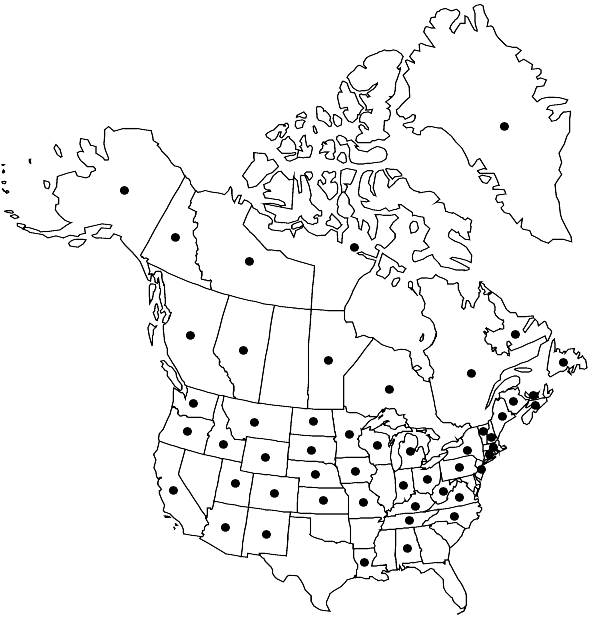Polytrichum piliferum
Sp. Musc. Frond., 90. 1801,.
Plants small to medium, glaucous green to reddish brown, in loose tufts. Stems (0.5–)1–4 cm tall, rather wiry, unbranched, comose at the tips, whitish tomentose only near the base. Leaves (2–)3–4 mm, erect, straight and slightly incurved when dry, erect-spreading when moist; sheath ovate, ± contracted to the blade; blade linear-lanceolate, turgid, with sharply infolded margins, the leaf apex abruptly contracted to the base of the awn; marginal lamina 5–8 cells wide, 1-stratose, membranous, entire to finely serrulate toward the apex, enclosing the lamellae and overlapping in distal half or more; costa typically smooth abaxially, long-excurrent as a spinulose-toothed, hyaline awn; lamellae in profile crenulate-dentate to serrulate, with crenulations directed towards the leaf apex, (4–)6–8 cells high, the marginal cells in section conic to distinctly pyriform, terminating in a distinct knob, the marginal cells of the lateral lamellae ovoid, thinner-walled; sheath cells 60–80 × 10–15 µm, elongate-rectangular (4–6:1); cells of marginal lamina transversely elongated, ± irregular and sinuous, smaller toward the margins and obliquely oriented, especially approaching the apex, thick-walled. Sexual condition dioicous; perigonia intense wine-red; perichaetial leaves a little longer than foliage leaves, with hyaline lamina and longer awns. Seta 1–3 cm, stout, flexuose, reddish brown. Capsule 2.5–3.5 mm, short to almost cubic (1.5–2:1), inclined, becoming horizontal when mature; peristome rather short, 110–180(–200) µm, divided to 0.6, the teeth about 64, obtuse. Calyptra dirty white to light brown, enclosing the capsule. Spores 9–12 µm.
Habitat: Shallow well-drained sandy or gravelly soil over rocks and boulders in sunny situations, often associated with Cladonia, in road cuts, old fields, burned over areas, heaths, rocky ridges and moraines, and in dry alpine tundra and late snow areas northward
Elevation: low to moderate elevations
Distribution

Greenland, Alta., B.C., Man., N.B., Nfld. and Labr., N.W.T., N.S., Nunavut, Ont., P.E.I., Que., Yukon, Ala., Alaska, Ariz., Calif., Colo., Conn., Idaho, Ind., Iowa, Kans., Ky., La., Maine, Mass., Mich., Minn., Mo., Mont., Nebr., N.H., N.J., N.Mex., N.Y., N.C., N.Dak., Ohio, Oreg., Pa., S.Dak., Tenn., Utah, Vt., Va., Wash., W.Va., Wis., Wyo., South America, Europe, Asia, Atlantic Islands (Falkland Islands, Macaronesia), Pacific Islands (Hawaii), Australia, Antarctica.
Discussion
Polytrichum piliferum is easily recognized by its habit, growing in short, loose reddish brown clumps, each plant crowned by a whitish tuft of intertwined hyaline awns. The intensely colored, wine-red antheridial rosettes are remarkably flower-like in appearance. The lamella marginal cells are pyriform in section, ending in a distinct knob, except for the lamellae standing in the shade of the inflexed lamina. The leaves of P. piliferum are smooth abaxially and abruptly contracted to the base of the awn; P. juniperinum is a larger plant with reddish rather than hyaline awns; P. hyperboreum is typically fastigiately branched, the leaves with a channeled leaf apex, tapering to a bicolored awn. In Nunavut, it is known from Baffin and Melville islands.
Selected References
None.